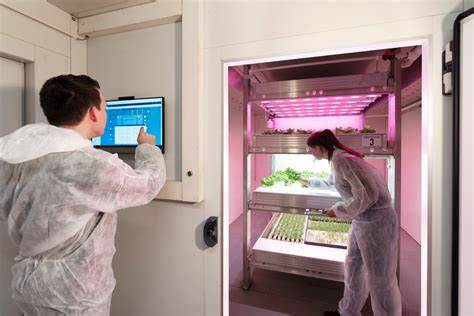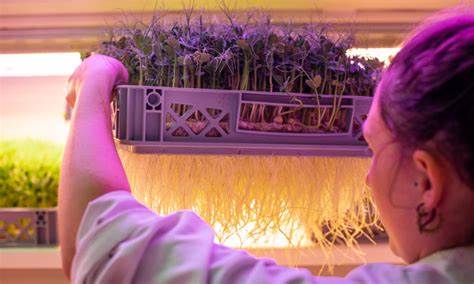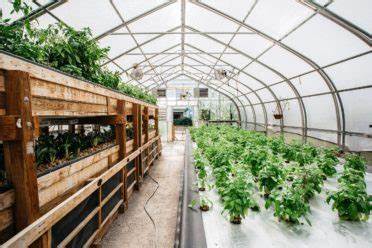
Vertical Farming: Revolutionizing Education Through Sustainable Agriculture
Introduction
Vertical farming has emerged as a groundbreaking concept in modern agriculture, offering a unique learning experience that combines science, technology, and sustainability. This article explores the relevance and importance of vertical farming as a learning tool, providing hands-on opportunities for students to engage with innovative farming techniques.
Historical Background
The concept of vertical farming can be traced back to the early 20th century when visionaries began experimenting with ways to maximize growing space in urban environments. Over time, advancements in technology and agriculture have paved the way for the development of vertical farming systems, revolutionizing the way we grow crops.
Key Concepts and Definitions
Vertical farming can be defined as the practice of cultivating crops in vertically stacked layers, utilizing methods such as hydroponics and aeroponics. Hydroponics involves growing plants in nutrient-rich water, while aeroponics involves misting the roots with nutrient solutions. These key terms are essential to understanding the principles behind vertical farming.
Benefits of Vertical Farming as a Learning Experience
Hands-on Learning Opportunities
Vertical farming provides students with practical experiences in plant cultivation, allowing them to develop a deeper understanding of the science behind agriculture. Through hands-on activities, students can learn about the importance of light, pH levels, and nutrient requirements for optimal plant growth.

Integration of STEM Education
Vertical farming seamlessly integrates science, technology, engineering, and mathematics (STEM) subjects, offering interdisciplinary learning opportunities. Students can explore concepts such as sustainability, environmental science, and data analysis, fostering critical thinking and problem-solving skills.
Cultivation of Sustainable Practices
Vertical farming promotes sustainable agriculture practices by reducing water consumption, minimizing pesticide use, and eliminating the need for large-scale land clearing. Students gain a broader understanding of the importance of sustainable practices and their role in addressing global food security challenges.
Educational Applications of Vertical Farming
Integration into School Curricula
Vertical farming can be incorporated into various subjects across the curriculum, including biology, environmental science, and even business studies. By integrating vertical farming into lesson plans, educators can create engaging and relevant learning experiences for students.
Collaborative Projects and Interdisciplinary Learning
Vertical farming encourages collaboration among students from different disciplines. For example, biology students can work with technology students to design and build efficient vertical farming systems. This collaborative approach fosters teamwork and exposes students to real-world problem-solving scenarios.
Entrepreneurship and Career Development in Agriculture
Vertical farming presents opportunities for students to explore entrepreneurship and potential careers in the agricultural sector. Students can learn about the business aspects of vertical farming, develop marketing strategies, and understand the economic viability of sustainable agriculture practices.
Case Studies or Examples
Vertical Farming in a High School Biology Class
In a high school biology class, vertical farming was integrated into the curriculum as a hands-on learning experience. Students learned about plant biology, nutrition, and the environmental factors influencing plant growth. The project helped students develop critical thinking skills and enhanced their understanding of sustainable agriculture practices.

Vertical Farming in a University Research Project
In a university research project, vertical farming was used to investigate the potential of growing specific crops in controlled environments. The research objectives included optimizing growth conditions, measuring crop yields, and analyzing the nutritional content of the harvested produce. Findings from this study have implications for future research and commercial vertical farming operations.
Current Trends or Developments
Innovations in Vertical Farming Technology
Continuous advancements in vertical farming technology have led to the development of more efficient and automated systems. Innovations such as smart lighting systems, robotic seeding and harvesting, and data analytics have improved crop production and minimized resource consumption.
Expansion of Vertical Farming Initiatives Globally
Vertical farming initiatives have gained traction worldwide, with urban centers embracing this sustainable farming method. From rooftop gardens in densely populated cities to vertical farms in rural communities, the adoption of vertical farming is expanding and diversifying.
Research Findings on the Educational Benefits of Vertical Farming
Recent research has highlighted the positive educational outcomes associated with vertical farming. Studies have shown that students engaged in vertical farming projects demonstrate increased interest in science, improved problem-solving abilities, and a greater understanding of the importance of sustainable agriculture.
Challenges or Controversies
The Cost and Feasibility of Implementing Vertical Farms in Educational Institutions
One of the primary challenges of implementing vertical farming in educational institutions is the initial investment cost. Setting up vertical farming systems requires specialized equipment, lighting, and technology, which can be expensive for schools with limited budgets.
Concerns about the Lack of Traditional Farming Skills and Knowledge
Critics argue that vertical farming may lead to a disconnect between students and traditional farming practices. While vertical farming offers innovative solutions for sustainable agriculture, it is crucial to ensure that students also learn about traditional farming methods to maintain a holistic understanding of food production.
Controversies Surrounding the Commercialization of Vertical Farming
The commercialization of vertical farming has sparked debates regarding the impact on traditional agriculture and small-scale farmers. Some argue that large-scale vertical farming operations may lead to the displacement of traditional farmers and consolidation of agricultural production.

Future Outlook
Potential Growth and Adoption of Vertical Farming in Education
The future of vertical farming in education looks promising, with the potential for increased adoption and integration into curricula worldwide. As awareness of the benefits of vertical farming grows, educational institutions are likely to invest in sustainable agricultural practices to equip students with essential skills for the future.
Integration of Vertical Farming with Emerging Technologies
The integration of vertical farming with emerging technologies such as artificial intelligence holds immense potential. AI-powered vertical farming systems can optimize resource allocation, predict crop yields, and enhance overall efficiency, revolutionizing the way we grow food sustainably.
Implications for Food Security and Sustainability
Vertical farming has the potential to address food security and sustainability challenges by providing a reliable source of fresh produce in urban areas and reducing the environmental impact of traditional farming. As vertical farming continues to evolve, it can contribute to a more sustainable and resilient food system.
Conclusion
In conclusion, vertical farming offers a transformative learning experience that combines science, technology, and sustainability. By integrating vertical farming into educational settings, students gain valuable skills and knowledge that are essential for addressing global challenges related to food security and sustainability.




